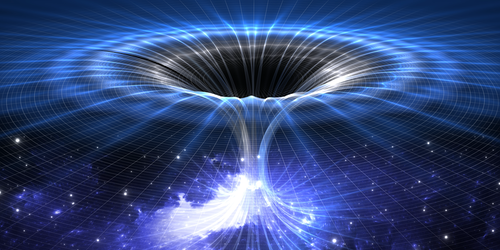Wormholes Open for Transport
A wormhole is a hypothetical shortcut that could connect one side of a galaxy to another. Despite populating many science-fiction plots, wormholes have been hard to justify theoretically. Now, two separate groups present models that make wormholes seem less exotic and slightly more credible for human use [1, 2].
The idea of a wormhole is nearly as old as that of a black hole. However, the existence of wormholes remains an open question. Even if a wormhole could form, the gravitational attraction of the matter inside it would presumably cause its throat (the narrowest point in the tunnel) to close, preventing travel from one side to the other. Theorists have proposed ways to keep a wormhole open, usually by adding exotic matter whose properties resist the gravitational collapse. Now Jose Blázquez-Salcedo from the Complutense University of Madrid and his colleagues have found a traversable wormhole solution that requires no exotic matter [1].
The team model their wormhole using a semiclassical framework, in which matter is treated as a set of generic fermions (spin-1/2 particles, such as electrons and positrons) described by quantum wave functions. Matter interacts through classical electromagnetic fields, which simplifies the equations.
By varying parameters, including the fermions’ charge and mass, Blázquez-Salcedo and his colleagues found that traversable wormholes could exist when the ratio of the total charge to the total mass within the wormhole exceeds a theoretical limit that applies to black holes. The researchers speculate that this solution should remain valid in a more complete model, where the fields corresponding to matter interactions are quantized.
But the wormholes that Blázquez-Salcedo and his colleagues envision are microscopic—too small for any human to squeeze through. Juan Maldacena from the Institute for Advanced Study, New Jersey, and Alexey Milekhin from Princeton University have explored wormholes that would provide safe passage to an intrepid voyager [2]. Their model assumes that wormholes form in a five-dimensional spacetime, as proposed in some string-theory cosmologies (see Focus: An Invisible Dimension). The researchers show that a human-friendly wormhole—with accelerations less than 20 g—could allow a cross-galaxy journey in less than a second. This short duration would only apply to the person in the wormhole, as an outside observer would measure the trip as lasting thousands of years.
–Michael Schirber
Michael Schirber is a Corresponding Editor for Physics Magazine based in Lyon, France.
References
- J. L. Blázquez-Salcedo et al., “Traversable wormholes in Einstein-Dirac-Maxwell theory,” Phys. Rev. Lett. 126, 101102 (2021).
- J. Maldacena and A. Milekhin, “Humanly traversable wormholes,” Phys. Rev. D 103, 066007 (2021).





